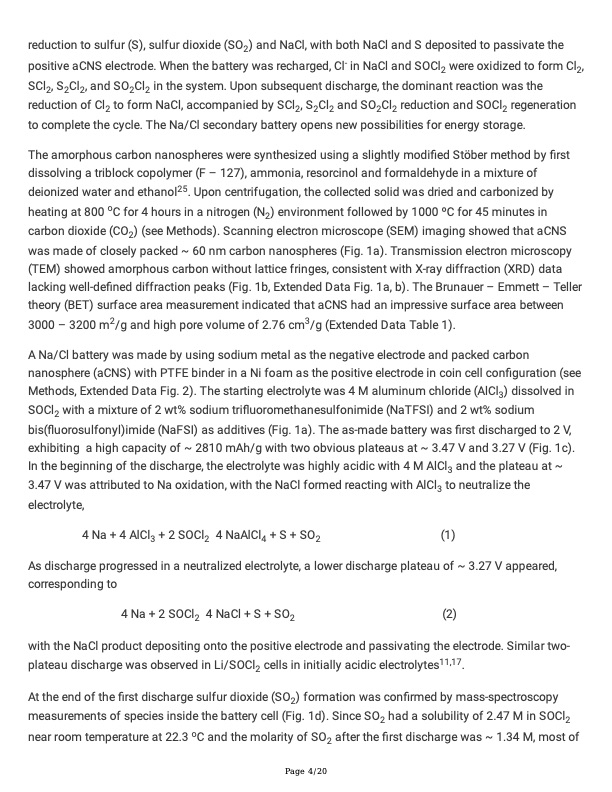
PDF Publication Title:
Text from PDF Page: 004
reduction to sulfur (S), sulfur dioxide (SO2) and NaCl, with both NaCl and S deposited to passivate the positive aCNS electrode. When the battery was recharged, Cl- in NaCl and SOCl2 were oxidized to form Cl2, SCl2, S2Cl2, and SO2Cl2 in the system. Upon subsequent discharge, the dominant reaction was the reduction of Cl2 to form NaCl, accompanied by SCl2, S2Cl2 and SO2Cl2 reduction and SOCl2 regeneration to complete the cycle. The Na/Cl secondary battery opens new possibilities for energy storage. The amorphous carbon nanospheres were synthesized using a slightly modi�ed Stöber method by �rst dissolving a triblock copolymer (F – 127), ammonia, resorcinol and formaldehyde in a mixture of deionized water and ethanol25. Upon centrifugation, the collected solid was dried and carbonized by heating at 800 oC for 4 hours in a nitrogen (N2) environment followed by 1000 oC for 45 minutes in carbon dioxide (CO2) (see Methods). Scanning electron microscope (SEM) imaging showed that aCNS was made of closely packed ~ 60 nm carbon nanospheres (Fig. 1a). Transmission electron microscopy (TEM) showed amorphous carbon without lattice fringes, consistent with X-ray diffraction (XRD) data lacking well-de�ned diffraction peaks (Fig. 1b, Extended Data Fig. 1a, b). The Brunauer – Emmett – Teller theory (BET) surface area measurement indicated that aCNS had an impressive surface area between 3000 – 3200 m2/g and high pore volume of 2.76 cm3/g (Extended Data Table 1). A Na/Cl battery was made by using sodium metal as the negative electrode and packed carbon nanosphere (aCNS) with PTFE binder in a Ni foam as the positive electrode in coin cell con�guration (see Methods, Extended Data Fig. 2). The starting electrolyte was 4 M aluminum chloride (AlCl3) dissolved in SOCl2 with a mixture of 2 wt% sodium tri�uoromethanesulfonimide (NaTFSI) and 2 wt% sodium bis(�uorosulfonyl)imide (NaFSI) as additives (Fig. 1a). The as-made battery was �rst discharged to 2 V, exhibiting a high capacity of ~ 2810 mAh/g with two obvious plateaus at ~ 3.47 V and 3.27 V (Fig. 1c). In the beginning of the discharge, the electrolyte was highly acidic with 4 M AlCl3 and the plateau at ~ 3.47 V was attributed to Na oxidation, with the NaCl formed reacting with AlCl3 to neutralize the electrolyte, 4Na+4AlCl3 +2SOCl2 4NaAlCl4 +S+SO2 (1) As discharge progressed in a neutralized electrolyte, a lower discharge plateau of ~ 3.27 V appeared, corresponding to 4Na+2SOCl2 4NaCl+S+SO2 (2) with the NaCl product depositing onto the positive electrode and passivating the electrode. Similar two- plateau discharge was observed in Li/SOCl2 cells in initially acidic electrolytes11,17. At the end of the �rst discharge sulfur dioxide (SO2) formation was con�rmed by mass-spectroscopy measurements of species inside the battery cell (Fig. 1d). Since SO2 had a solubility of 2.47 M in SOCl2 near room temperature at 22.3 oC and the molarity of SO2 after the �rst discharge was ~ 1.34 M, most of Page 4/20PDF Image | Rechargeable NaCl Battery Hongjie

PDF Search Title:
Rechargeable NaCl Battery HongjieOriginal File Name Searched:
A_Rechargeable_NaCl_Battery.pdfDIY PDF Search: Google It | Yahoo | Bing
Product and Development Focus for Salgenx
Redox Flow Battery Technology: With the advent of the new USA tax credits for producing and selling batteries ($35/kW) we are focussing on a simple flow battery using shipping containers as the modular electrolyte storage units with tax credits up to $140,000 per system. Our main focus is on the salt battery. This battery can be used for both thermal and electrical storage applications. We call it the Cogeneration Battery or Cogen Battery. One project is converting salt (brine) based water conditioners to simultaneously produce power. In addition, there are many opportunities to extract Lithium from brine (salt lakes, groundwater, and producer water).Salt water or brine are huge sources for lithium. Most of the worlds lithium is acquired from a brine source. It's even in seawater in a low concentration. Brine is also a byproduct of huge powerplants, which can now use that as an electrolyte and a huge flow battery (which allows storage at the source).We welcome any business and equipment inquiries, as well as licensing our flow battery manufacturing.| CONTACT TEL: 608-238-6001 Email: greg@salgenx.com | RSS | AMP |